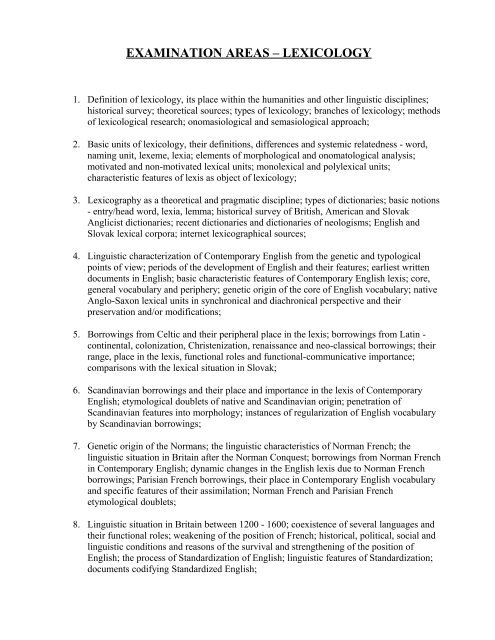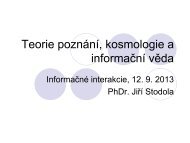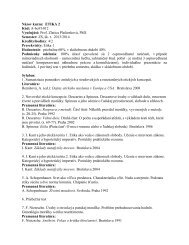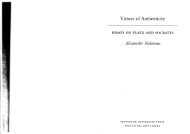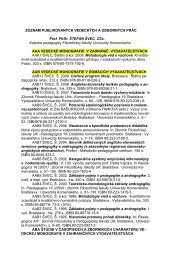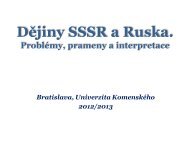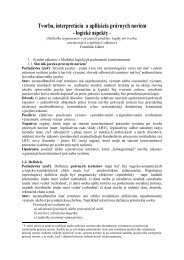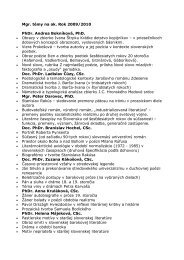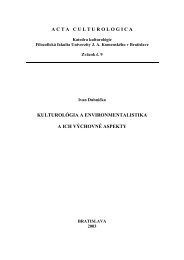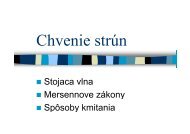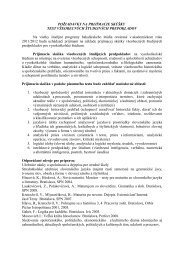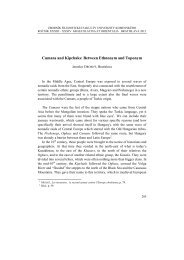Schedule of English Lexicology 1 Lectures
Schedule of English Lexicology 1 Lectures
Schedule of English Lexicology 1 Lectures
You also want an ePaper? Increase the reach of your titles
YUMPU automatically turns print PDFs into web optimized ePapers that Google loves.
EXAMINATION AREAS – LEXICOLOGY<br />
1. Definition <strong>of</strong> lexicology, its place within the humanities and other linguistic disciplines;<br />
historical survey; theoretical sources; types <strong>of</strong> lexicology; branches <strong>of</strong> lexicology; methods<br />
<strong>of</strong> lexicological research; onomasiological and semasiological approach;<br />
2. Basic units <strong>of</strong> lexicology, their definitions, differences and systemic relatedness - word,<br />
naming unit, lexeme, lexia; elements <strong>of</strong> morphological and onomatological analysis;<br />
motivated and non-motivated lexical units; monolexical and polylexical units;<br />
characteristic features <strong>of</strong> lexis as object <strong>of</strong> lexicology;<br />
3. Lexicography as a theoretical and pragmatic discipline; types <strong>of</strong> dictionaries; basic notions<br />
- entry/head word, lexia, lemma; historical survey <strong>of</strong> British, American and Slovak<br />
Anglicist dictionaries; recent dictionaries and dictionaries <strong>of</strong> neologisms; <strong>English</strong> and<br />
Slovak lexical corpora; internet lexicographical sources;<br />
4. Linguistic characterization <strong>of</strong> Contemporary <strong>English</strong> from the genetic and typological<br />
points <strong>of</strong> view; periods <strong>of</strong> the development <strong>of</strong> <strong>English</strong> and their features; earliest written<br />
documents in <strong>English</strong>; basic characteristic features <strong>of</strong> Contemporary <strong>English</strong> lexis; core,<br />
general vocabulary and periphery; genetic origin <strong>of</strong> the core <strong>of</strong> <strong>English</strong> vocabulary; native<br />
Anglo-Saxon lexical units in synchronical and diachronical perspective and their<br />
preservation and/or modifications;<br />
5. Borrowings from Celtic and their peripheral place in the lexis; borrowings from Latin -<br />
continental, colonization, Christenization, renaissance and neo-classical borrowings; their<br />
range, place in the lexis, functional roles and functional-communicative importance;<br />
comparisons with the lexical situation in Slovak;<br />
6. Scandinavian borrowings and their place and importance in the lexis <strong>of</strong> Contemporary<br />
<strong>English</strong>; etymological doublets <strong>of</strong> native and Scandinavian origin; penetration <strong>of</strong><br />
Scandinavian features into morphology; instances <strong>of</strong> regularization <strong>of</strong> <strong>English</strong> vocabulary<br />
by Scandinavian borrowings;<br />
7. Genetic origin <strong>of</strong> the Normans; the linguistic characteristics <strong>of</strong> Norman French; the<br />
linguistic situation in Britain after the Norman Conquest; borrowings from Norman French<br />
in Contemporary <strong>English</strong>; dynamic changes in the <strong>English</strong> lexis due to Norman French<br />
borrowings; Parisian French borrowings, their place in Contemporary <strong>English</strong> vocabulary<br />
and specific features <strong>of</strong> their assimilation; Norman French and Parisian French<br />
etymological doublets;<br />
8. Linguistic situation in Britain between 1200 - 1600; coexistence <strong>of</strong> several languages and<br />
their functional roles; weakening <strong>of</strong> the position <strong>of</strong> French; historical, political, social and<br />
linguistic conditions and reasons <strong>of</strong> the survival and strengthening <strong>of</strong> the position <strong>of</strong><br />
<strong>English</strong>; the process <strong>of</strong> Standardization <strong>of</strong> <strong>English</strong>; linguistic features <strong>of</strong> Standardization;<br />
documents codifying Standardized <strong>English</strong>;
9. Developments <strong>of</strong> <strong>English</strong> between 1700 -1900; wide internationalization <strong>of</strong> <strong>English</strong><br />
wordstock; direct and indirect borrowings from various languages and their assimilation;<br />
rise <strong>of</strong> geographical variants <strong>of</strong> <strong>English</strong>; basic characterization <strong>of</strong> lexical differences in<br />
American, Canadian and Australian <strong>English</strong> with regard to British <strong>English</strong>;<br />
10. Further extension and internationalization <strong>of</strong> <strong>English</strong> vocabulary; extension <strong>of</strong><br />
terminological vocabulary; diversification <strong>of</strong> linguistic roles and dynamic developments in<br />
colloqual <strong>English</strong> and slang; neologisms in the 20th century;<br />
11. Internationalization <strong>of</strong> the roles <strong>of</strong> <strong>English</strong>; rise <strong>of</strong> International <strong>English</strong>; <strong>English</strong> as a<br />
source <strong>of</strong> borrowings; borrowings from <strong>English</strong> in Slovak - historical considerations,<br />
communicative roles, socio-linguistic attitudes to them, their assimilation processes and<br />
dynamic developments;<br />
12. Borrowing as a word-formative process; reasons <strong>of</strong> borrowing; sources <strong>of</strong> borrowing;<br />
origin <strong>of</strong> borrowing; assimilation <strong>of</strong> borrowings; barbarisms, foreignisms;<br />
internationalisms; non-parallel internationalisms; faux amis; paronyms<br />
13. General classification <strong>of</strong> word-formation; language-inherent and language-adherent wordformative<br />
processes; types <strong>of</strong> word-formative processes in <strong>English</strong> and their<br />
characterization; productive and non-productive word-formative processes; comparisons<br />
with the classification <strong>of</strong> word-formative processes in Slovak<br />
14. Derivation as a word-formative process in <strong>English</strong>; etymology <strong>of</strong> affixes; native and<br />
borrowed affixes; productive and non-productive affixes; valency <strong>of</strong> affixes; hybrids;<br />
comparisons with Slovak;<br />
15. Class-changing affixes in <strong>English</strong>; all<strong>of</strong>orms <strong>of</strong> affixes; affixoids and radixoids; polysemy,<br />
homonymy and synonymy <strong>of</strong> affixes; semantic classification <strong>of</strong> affixes; phonetic,<br />
phonological, suprasegmental and graphical modifications due to derivation; comparisons<br />
with Slovak;<br />
16. Conversion as a word-formative process in <strong>English</strong>; historical development <strong>of</strong> conversion;<br />
types and contemporary productivity <strong>of</strong> conversion; partial conversion; semantic<br />
consequences <strong>of</strong> conversion; enantiosemy; comparisons with Slovak;<br />
17. Compounding as a word-formative process in <strong>English</strong>; theories <strong>of</strong> compounding;<br />
classification <strong>of</strong> compounds according to their categorial constituents and resulting wordcategory;<br />
endocentric and exocentric compounds; bahuvrihi and tatpurusha compounds;<br />
repetitive compounds, ablaut and rhyme combinations; pseudo-compounds; faded<br />
motivation and compounding; comparisons with Slovak;<br />
18. Shortening as a word-formative process in <strong>English</strong>; historical development <strong>of</strong> shortening;<br />
classification <strong>of</strong> shortenings - lexical shortenings, abbreviation into initial letters,<br />
acronyms, contractions; communicative and stylistic functions <strong>of</strong> shortenings;<br />
comparisons with Slovak;
19. Blending as a word-formative process in <strong>English</strong>; historical development <strong>of</strong> blending;<br />
classification <strong>of</strong> blends; neological blends; word-formative potential <strong>of</strong> blending;<br />
communicative impact <strong>of</strong> blends; blends in Slovak;<br />
20. Back-formation as a word-formative process in <strong>English</strong>; historical development <strong>of</strong> backformation;<br />
classification <strong>of</strong> back-formations; productivity and non-productivity <strong>of</strong> the<br />
particular types;<br />
21. Sound changes, sound imitation and artificial word-formation; symbols used in electronic<br />
communication; neological word-formative tendencies; ad-hoc formations; stylistic<br />
revaluation;<br />
22. Semantic change as a word-formative process; types <strong>of</strong> semantic change; semantic change<br />
resulting in polysemy, split <strong>of</strong> polysemy, homonymy,<br />
23. Phraseology and its place in the <strong>English</strong> linguistic system; origin <strong>of</strong> phraseologisms; types<br />
<strong>of</strong> phraseologisms; definition <strong>of</strong> idioms, phrasemes, phraseological collocations, proverbs<br />
and sayings; clichés; communicative and stylistic functions <strong>of</strong> phraseologisms


